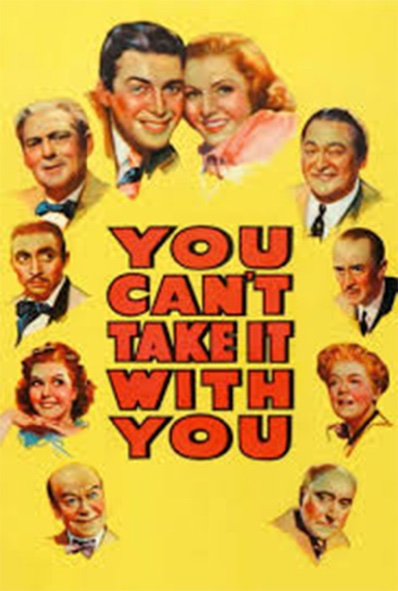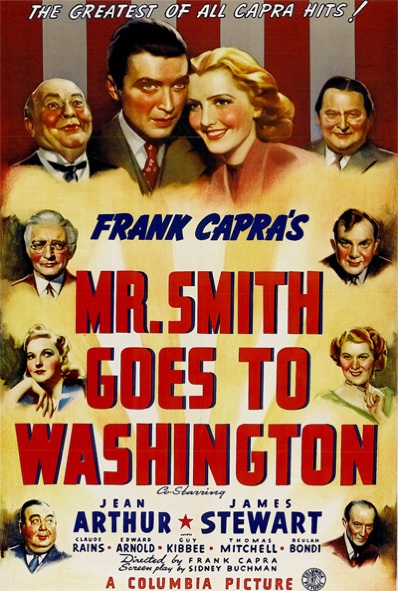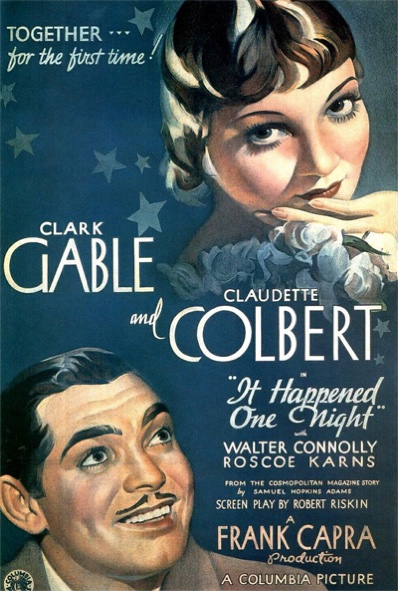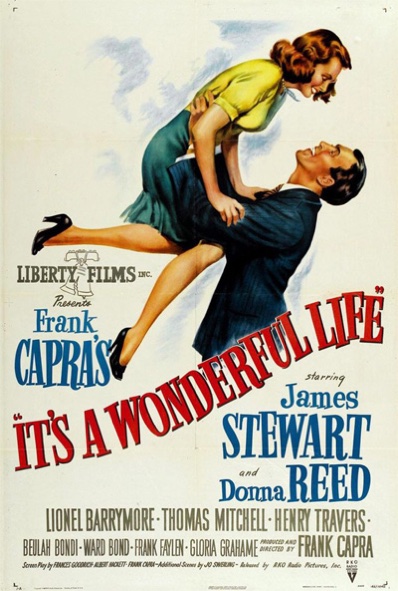
Frank Capra
Best known as the creative force behind some of the biggest award-winning films of the 1930s and ’40s. Born in Italy and raised in Los Angeles from the age of five, his rags-to-riches story has led film historians to consider him the “American dream personified.”
Frank Capra is one of the most successful and beloved filmmakers ever. The only other directors (also immigrants) to have three films in the American Film Institutes Top Fifty are Alfred Hitchcock and Billy Wilder. Like those two, also, there is no mistaking a Capra film. (Well, actually there is a bit of mistaking him; you can be forgiven for confusing Capra’s stage adaptations with George Cukor’s.)
Capra packed a whole lot of “message” in his films. There is no mistaking he was on the side of the underdog, and the wealthy and powerful (as well as journalists) were often the bad guys. Its, of course, a blemish on the face of America that such a symbol of the American Dream, a patriot and veteran of both World Wars, and a champion of the average Joe would have been a victim of the below-average Joe… McCarthy.
His work was also stuck with the stupefyingly shortsighted label, “Capra-corn”. Just as his masterpiece, “It’s A Wonderful Life“, was fascinatingly dark, much of his work portrays an America that is none too pretty. Gullibility, larceny, cynicism, greed and many other sins were his stock players, hardly the stuff of corn.
And yet, Frank Capra personified, in his life and in his work, the American Dream.
Six years old, he came to America from Sicily at the turn of the century in the stinking hull of a ship with his family. They moved to California to be with his older brother. He sold newspapers on the street corner. Against his family’s wishes, he stayed in school. He was the top student at what would eventually become Cal Tech. It was there, ironically, that he discovered the arts.
After World War I, Capra took a variety of jobs: as an extra in John Ford’s “Outcasts of Poker Flats;” directing and editing short silent films; as a gag writer for Hal Roach and then Mack Sennett. Frank then cut his teeth directing Harry Langdon films.
Harry Cohn brought Capra to the fledgling Columbia Pictures in the late ’20s, where they would make films, fighting all the way, for over a decade. Capra made several successful films in the early ‘30s with Barbara Stanwyck (and would make several others through the years), but his first classic was with Claudette Colbert and Clark Gable, “It Happened One Night“.
Said to be the original screwball comedy, neither star really wanted to be in the picture, but both won Oscars as did Capra and Cohn (for Best Picture). Before that “Night”, Columbia was a “second-rate poverty row” studio. Afterward, Capra, now a producer-director, did what he wanted to do, and his name would be forever above the title.
“Mr. Deeds Goes to Town” (1936) was delayed six months so that Capra could have the perfect man to play Longfellow Deeds — Gary Cooper. A “wise and honest country mouse” who inherits millions is humiliated by moneyed interests eager to add his stacks of money to their own. They try to have him declared insane when he decides to give it all away. Cooper, like Jimmy Stewart, is brilliant at playing the all-American fellow, driven to virtual madness by the corruption around him. Capra won another Oscar for the film.
Maybe getting a little too carried away with himself, Capra’s version of “Lost Horizon” (1937) was first six hours, then three and a half. Though he was nominated for still another Oscar, it was the set, appropriately, that won. Though his next film was also an adaptation, it couldn’t have been more different (except in a somewhat different version of a Utopian perspective).
“You Can’t Take it With You” (1938), from the Pulitzer-winning Kaufman and Hart play, is so packed with tour-de-force performances that it becomes more a collection of scenes than a story, and a treatise more on individuality than on any political statement. Frank Capra won two Oscars for this one — Best Director and Best Picture.
Probably the best praise for the classic “Mr. Smith Goes to Washington” (1939) was that Washington society was outraged by it and European Fascists banned it because they thought it presented democracy too positively. One cant imagine now, of course, that the idea of a corrupt senator was so controversial, but that idea reveals a much more daring Frank Capra than one would suppose. Supposedly responsible for encouraging legions of Americans to try their hand at politics, it would discourage most reasonable people. Though it was nominated for 11 Oscars, it only won one — no small feat considering that 1939 was Film’s Greatest Year.
If “Mr. Smith” was deemed outrageous, “Meet John Doe” (1941) was downright revolutionary. Teaming Gary Cooper and Barbara Stanwyck, the film portrays a cynical newspaperwoman turning an ex-ballplayer down on his luck into the ‘40s version of a media superstar, with disastrous consequences. The last of Capra’s portraits of Depression-era America (except for the run on the bank scene in “It’s A Wonderful Life”), it was also his darkest.
During World War II, with the rank of Major, Capra made war propaganda films. With his love of America coming through, these, too, remain classic films.
After the war, now with his own Liberty Studios, Capra would make his last great film, “It’s A Wonderful Life“. Probably more peoples’ favorite film (including Jimmy Stewart), the sad irony is that it did so poorly at the box office it forced Capra to sell Liberty Studios. Capra’s last directorial and best picture nominations, the film was named by AFI as the most powerful film of all time. Like John Doe, Frank Capra would experience the worst of a moody, fickle American public, only to be redeemed by time.
That would be the last of the greats from the hand of Frank Capra. He still did some good films for several more years (including some brilliant educational films), but to talk about them only seems to dilute his true contributions to the American cinema. Whether it is to get the clearest view of Depression-era America, to be uplifted by his sometimes Christ-like heroes, prevailing both with and against the American tide, Americans seek out the work of the American Dreamer. And, of course, they make his greatest masterpiece an annual tradition at Christmas, earning Frank his wings over and over and over…
— Nate Lee
Memorable Quotes by Frank Capra
“Behind every successful man there stands an astonished woman.”
“My advice to young filmmakers is this: Don’t follow trends. Start them!”
“There are no rules in filmmaking. Only sins. And the cardinal sin is dullness.”
“James Stewart’s appeal lay in being so unusually usual.”
“Film is a disease. When it infects your bloodstream, it takes over as the number one hormone; it bosses the enzymes; directs the pineal gland; plays Iago to your psyche. As with heroin, the antidote to film is more film.
Do not help the quick moneymakers who have delusions about taking possession of classics by smearing them with paint.”
Things You May Not Know About Frank Capra
He got his first film assignment by answering an ad in a Los Angeles newspaper.
Critics dubbed his movies as “Capra-corn” for their simple and sappy storylines.
His father, Turiddu, died in a horrible factory accident in 1915. When the aging man was working some gears, he got caught in the gears and was nearly ripped in half.
Had a son, Johnny, who died in 1938, at age 3, from complications arising from a tonsillectomy.
Claimed that both Barbara Stanwyck and Frank Sinatra “left their best scenes in rehearsal,” saying that all subsequent takes got stale quickly. Capra would often shoot scenes with them without any rehearsing at all.
About Ladies of Leisure (1930) with a very young Barbara Stanwyck, Capra later wrote that he would have married her if both of them had been free at the time.
Great Scenes:
- The “walls of Jericho” scenes in the hotel room, with a blanket separating the bickering pair
- The famous hitchhiking scene, in which Colbert’s leg shows up Gable’s thumb
MR. DEEDS GOES TO TOWN
- Cooper punches the cynical writers at a fancy New York restaurant, then goes out on the town with one of the survivors
- The “pixilated” ladies in the courtroom
- Kolenkhov wrestling Mr. Kirby
- The dinner table scenes
- The dinner scene where Jimmy Stewart makes Jean Arthur scream
- Every word that the great Lionel Barrymore utters
- Jimmy Stewart dropping his hat around the pretty girls
- The stunning performance by Stewart holding a one-person filibuster in the Senate, just before he faints
- The “phone scene” in which Stewart declares his love for Donna Reed was perfect in one take
- Falling into the swimming pool while dancing at the high school
- The ending (of course)
Best Films:
- It’s A Wonderful Life
- Mr. Smith Goes to Washington
- Mr. Deeds Goes to Town
- It Happened One Night
- Meet John Doe
Great Film Adaptations:
Frank Capra’s directing credits include…
| Year | Movie |
|---|---|
| 1926 | The Strong Man |
| 1927 | Long Pants |
| 1927 | For the Love of Mike |
| 1928 | That Certain Thing |
| 1928 | So This Is Love |
| 1928 | The Matinee Idol |
| 1928 | The Way of the Strong |
| 1928 | Say It with Sables |
| 1928 | Submarine |
| 1928 | The Power of the Press |
| 1929 | The Younger Generation |
| 1929 | The Donovan Affair |
| 1929 | Flight |
| 1930 | Ladies of Leisure |
| 1930 | Rain or Shine |
| 1931 | Dirigible |
| 1931 | The Miracle Woman |
| 1931 | Platinum Blonde |
| 1932 | Forbidden |
| 1932 | American Madness |
| 1932 | The Bitter Tea of General Yen |
| 1933 | Lady for a Day |
| 1934 | It Happened One Night |
| 1934 | Broadway Bill |
| 1936 | Mr. Deeds Goes to Town |
| 1937 | Lost Horizon |
| 1938 | You Can’t Take It with You |
| 1939 | Mr. Smith Goes to Washington |
| 1941 | Meet John Doe |
| 1944 | Arsenic and Old Lace |
| 1946 | It’s a Wonderful Life |
| 1948 | State of the Union |
| 1950 | Riding High |
| 1951 | Here Comes the Groom |
| 1959 | A Hole in the Head |
| 1961 | Pocketful of Miracles |































































